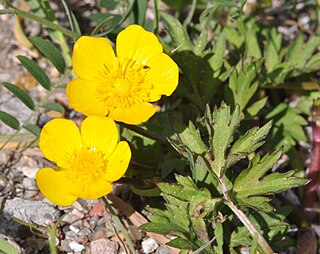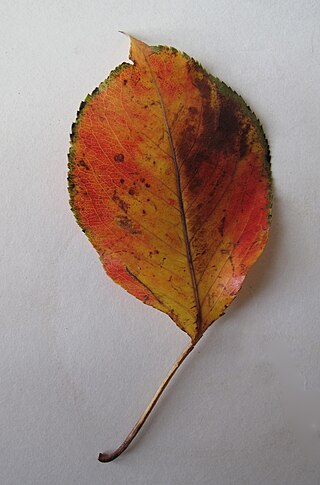Related Research Articles

Botany, also called plant science, plant biology or phytology, is the science of plant life and a branch of biology. A botanist, plant scientist or phytologist is a scientist who specialises in this field. The term "botany" comes from the Ancient Greek word βοτάνη meaning "pasture", "herbs" "grass", or "fodder"; βοτάνη is in turn derived from βόσκειν, "to feed" or "to graze". Traditionally, botany has also included the study of fungi and algae by mycologists and phycologists respectively, with the study of these three groups of organisms remaining within the sphere of interest of the International Botanical Congress. Nowadays, botanists study approximately 410,000 species of land plants of which some 391,000 species are vascular plants, and approximately 20,000 are bryophytes.

Flowering plants are plants that bear flowers and fruits, and form the clade Angiospermae, commonly called angiosperms. They include all forbs, grasses and grass-like plants, a vast majority of broad-leaved trees, shrubs and vines, and most aquatic plants. The term "angiosperm" is derived from the Greek words ἀγγεῖον / angeion and σπέρμα / sperma ('seed'), meaning that the seeds are enclosed within a fruit. They are by far the most diverse group of land plants with 64 orders, 416 families, approximately 13,000 known genera and 300,000 known species. Angiosperms were formerly called Magnoliophyta.

The lycophytes, when broadly circumscribed, are a group of vascular plants that include the clubmosses. They are sometimes placed in a division Lycopodiophyta or Lycophyta or in a subdivision Lycopodiophytina. They are one of the oldest lineages of extant (living) vascular plants; the group contains extinct plants that have been dated from the Silurian. Lycophytes were some of the dominating plant species of the Carboniferous period, and included the tree-like Lepidodendrales, some of which grew over 40 metres (130 ft) in height, although extant lycophytes are relatively small plants.

Sclereids are a reduced form of sclerenchyma cells with highly thickened, lignified cellular walls that form small bundles of durable layers of tissue in most plants. The presence of numerous sclereids form the cores of apples and produce the gritty texture of guavas.
Dioecy is a characteristic of certain species that have distinct unisexual individuals, each producing either male or female gametes, either directly or indirectly. Dioecious reproduction is biparental reproduction. Dioecy has costs, since only the female part of the population directly produces offspring. It is one method for excluding self-fertilization and promoting allogamy (outcrossing), and thus tends to reduce the expression of recessive deleterious mutations present in a population. Plants have several other methods of preventing self-fertilization including, for example, dichogamy, herkogamy, and self-incompatibility.
Dilleniidae is a botanical name at the rank of subclass. Circumscription of the subclass will vary with the taxonomic system being used; the only requirement being that it includes the family Dilleniaceae. A well-known system that uses this name is the Cronquist system, and in the original 1981 version of the system the circumscription was:

In botany, secondary growth is the growth that results from cell division in the cambia or lateral meristems and that causes the stems and roots to thicken, while primary growth is growth that occurs as a result of cell division at the tips of stems and roots, causing them to elongate, and gives rise to primary tissue. Secondary growth occurs in most seed plants, but monocots usually lack secondary growth. If they do have secondary growth, it differs from the typical pattern of other seed plants.
Paul Arnold Fryxell was an American botanist known for his work on flowering plants, especially those within the Malvaceae.

Jeffrey Barry Harborne FRS was a British chemist who specialised in phytochemistry. He was Professor of Botany at the University of Reading, 1976–93, then Professor emeritus. He contributed to more than 40 books and 270 research papers and was a pioneer in ecological biochemistry, particularly in the complex chemical interactions between plants, microbes and insects.

In botany, the petiole is the stalk that attaches the leaf blade to the stem. It is able to twist the leaf to face the sun, producing a characteristic foliage arrangement, and also optimizing its exposure to sunlight. Outgrowths appearing on each side of the petiole in some species are called stipules. The terms petiolate and apetiolate are applied respectively to leaves with and without petioles.

In biology, a phylum is a level of classification or taxonomic rank below kingdom and above class. Traditionally, in botany the term division has been used instead of phylum, although the International Code of Nomenclature for algae, fungi, and plants accepts the terms as equivalent. Depending on definitions, the animal kingdom Animalia contains about 31 phyla, the plant kingdom Plantae contains about 14 phyla, and the fungus kingdom Fungi contains about 8 phyla. Current research in phylogenetics is uncovering the relationships among phyla within larger clades like Ecdysozoa and Embryophyta.
Harold Charles Bold (1909–1987) was an American botanist.
Billie Lee Turner was an American botanist and professor of botany at the University of Texas at Austin where he also directed the botany research programme and herbarium.
George Hill Mathewson Lawrence was an American botanist, writer and professor of botany who helped establish the 'Liberty Hyde Bailey Hortorium', the Hunt Botanical Library and the Huntia journal. He was also an avid book collector, including books on the history of Rhode Island, historic books and botanical art.
Beryl B. Simpson is a professor emerita in the Department of Integrative Biology at the University of Texas at Austin. Previously she was an associate curator at the Smithsonian National Museum of Natural History in the Department of Botany. She studies plant systematics and tropical botany, focusing on angiosperms found in the American Southwest, Mexico, and Central and South America. She was awarded the José Cuatrecasas Medal for Excellence in Tropical Botany for her decades of work on the subject.
John Cameron Semple is a botanist, cytotaxonomist, professor emeritus, and adjunct professor at the University of Waterloo in Ontario, Canada. He was born in Boston and earned a degree of Bachelor of Science in 1969 from Tufts University, followed in 1971 and 1972 by Master of Arts and Doctor of Philosophy degrees from Washington University in St. Louis. Semple is known for his work with members of the tribe Astereae, particularly goldenrods, American asters, and goldenasters, and he maintains the University of Waterloo Astereae Lab website. Semple's wife is Brenda, and in 2013, he named a newly discovered goldenrod species Solidago brendiae in honor of her.
Laurence "Larry" Joseph Dorr is an American botanist and plant collector. He specializes in the systematics of the order Malvales and the family Ericaceae.
Emanuel David "Rudy" Rudolph was a botanist, lichenologist, and historian of botany. He was "the first botanist to conduct diverse experiments on the total biology of lichens in both polar regions".

Daniel I. Bolnick is an American evolutionary biologist. He is a full professor at the University of Connecticut. He was editor-in-chief of the journal The American Naturalist from 1998-2003, and President of The American Society of Naturalists in 2025.
Michael Joseph Ryan is an American biologist, author, Clark Hubbs Regents Professor in Zoology in the Department of Integrative Biology at the University of Texas at Austin, and Senior Research Associate at the Smithsonian Tropical Research Institute in Panama. He is considered to be a prominent expert in the fields of sexual selection and animal communication. Ryan has authored over 300 peer-reviewed scientific articles and publications on the evolution and mechanisms of animal behavior. His book The Túngara Frog: A Study of Sexual Selection and Communication is regarded as a classic in his field. He lives in Austin, Texas.
References
- ↑ "MAUSETH, JAMES D - Integrative Biology - CNS Directory". cns.utexas.edu. Retrieved 2019-06-26.
- ↑ Yost, Jenn; Ritter, Matt (January 2017). "Volume Dedication To James D. Mauseth". Madroño. 64 (1): 1–2. doi:10.3120/0024-9637-64.1.1. S2CID 90949989.